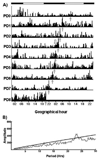The rabbit pup, a natural model of nursing-anticipatory activity
- PMID: 19863657
- PMCID: PMC2786307
- DOI: 10.1111/j.1460-9568.2009.06964.x
The rabbit pup, a natural model of nursing-anticipatory activity
Abstract
Mother rabbits nurse their young once a day with circadian periodicity. Nursing bouts are brief (ca. 3 min) and occur inside the maternal burrow. Despite this limited contact mother rabbits and their pups are tuned to each other to ensure that the capacities of each party are used efficiently to ensure the weaning of a healthy litter. In this review we present behavioral, metabolic and hormonal correlates of this phenomenon in mother rabbits and their pups. Research is revealing that the circadian rhythm of locomotion shifts in parallel to the timing of nursing in both parties. In pups corticosterone has a circadian rhythm with highest levels at the time of nursing. Other metabolic and hormonal parameters follow an exogenous or endogenous rhythm which is affected by the time of nursing. In the brain, clock genes and their proteins (e.g. Per1) are differentially expressed in specific brain regions (e.g. suprachiasmatic nucleus, paraventricular nucleus) in relation to providing or ingesting milk in mothers and young, respectively. These findings suggest that circadian activities are modulated, in the mothers, by suckling stimulation and, in the young, by the ingestion of milk and/or the perception of the mammary pheromone. In conclusion, the rabbit pup is an extraordinary model for studying the entraining by a single daily food pulse with minimal manipulations. The mother offers the possibility of studying nursing as a non-photic synchronizer, also with minimal manipulation, as suckling stimulation from the litter occurs only once daily.
Similar articles
-
Artificial feeding synchronizes behavioral, hormonal, metabolic and neural parameters in mother-deprived neonatal rabbit pups.Eur J Neurosci. 2011 Dec;34(11):1807-16. doi: 10.1111/j.1460-9568.2011.07898.x. Epub 2011 Nov 18. Eur J Neurosci. 2011. PMID: 22098455 Free PMC article.
-
Nature's food anticipatory experiment: entrainment of locomotor behavior, suprachiasmatic and dorsomedial hypothalamic nuclei by suckling in rabbit pups.Eur J Neurosci. 2008 Jan;27(2):432-43. doi: 10.1111/j.1460-9568.2008.06017.x. Eur J Neurosci. 2008. PMID: 18215239 Free PMC article.
-
Litter size determines circadian periodicity of nursing in rabbits.Chronobiol Int. 2013 Jun;30(5):711-8. doi: 10.3109/07420528.2013.784769. Epub 2013 May 20. Chronobiol Int. 2013. PMID: 23688115
-
Mothers and offspring: The rabbit as a model system in the study of mammalian maternal behavior and sibling interactions.Horm Behav. 2016 Jan;77:30-41. doi: 10.1016/j.yhbeh.2015.05.011. Epub 2015 Jun 7. Horm Behav. 2016. PMID: 26062431 Review.
-
Mother rabbits and their offspring: timing is everything.Dev Psychobiol. 2007 Jan;49(1):71-6. doi: 10.1002/dev.20196. Dev Psychobiol. 2007. PMID: 17186517 Review.
Cited by
-
A circadian clock in the olfactory bulb anticipates feeding during food anticipatory activity.PLoS One. 2012;7(10):e47779. doi: 10.1371/journal.pone.0047779. Epub 2012 Oct 19. PLoS One. 2012. PMID: 23094084 Free PMC article.
-
Palatable meal anticipation in mice.PLoS One. 2010 Sep 30;5(9):e12903. doi: 10.1371/journal.pone.0012903. PLoS One. 2010. PMID: 20941366 Free PMC article.
-
A pheromone to behave, a pheromone to learn: the rabbit mammary pheromone.J Comp Physiol A Neuroethol Sens Neural Behav Physiol. 2010 Oct;196(10):779-90. doi: 10.1007/s00359-010-0548-y. Epub 2010 Jun 24. J Comp Physiol A Neuroethol Sens Neural Behav Physiol. 2010. PMID: 20574828 Review.
-
Food Entrainment, Arousal, and Motivation in the Neonatal Rabbit Pup.Front Neurosci. 2021 Mar 17;15:636764. doi: 10.3389/fnins.2021.636764. eCollection 2021. Front Neurosci. 2021. PMID: 33815041 Free PMC article. Review.
-
Suckling induces a daily rhythm in the preoptic area and lateral septum but not in the bed nucleus of the stria terminalis in lactating rabbit does.Eur J Neurosci. 2015 Jan;41(2):196-204. doi: 10.1111/ejn.12776. Epub 2014 Nov 5. Eur J Neurosci. 2015. PMID: 25370159 Free PMC article.
References
-
- Abe H, Rusak B. Anticipatory activity and entrainment of circadian rhythms in Syrian hamsters exposed to restricted palatable diets. Am. J. Physiol. Regul. Integr. Comp. Physiol. 1992;295:R690–R695. - PubMed
-
- Akana SF, Strack AM, Hanson ES, Dallman MF. Regulation of activity in the hypothalamo-pituitary-adrenal axis is integral to a larger hypothalamic system that determines caloric flow. Endocrinology. 1994;135:1125–1134. - PubMed
-
- Allingham K, von Saldern C, Brennan PA, Distel H, Hudson R. Endogenous expression of c-Fos in hypothalamic nuclei of neonatal rabbits coincides with their circadian pattern of suckling-associated arousal. Brain Res. 1998;783:210–218. - PubMed
-
- Angeles-Castellanos M, Aguilar-Roblero R, Escobar C. C-Fos expression in hypothalamic nuclei of food-entrained rats. Am. J. Physiol. Reg. Integr. Physiol. 2004;286:R159–R165. - PubMed
-
- Angeles-Castellanos M, Mendoza J, Escobar C. Restricted feeding schedules phase shift daily rhythms of c-Fos and proteín Per1 immunoreactivity in corticolimbic regions in rats. Neuroscience. 2007;144:344–355. - PubMed
Publication types
MeSH terms
Substances
Grants and funding
LinkOut - more resources
Full Text Sources







